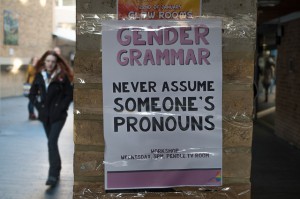Danish Pronouns – let’s get personal Posted by Bjørn A. Bojesen on Apr 15, 2016 in Grammar

Not exactly Danish, but I thought this photo was a perfect fit for the text. 🙂 (Courtesy of DaveBleasdale at Flickr, CC License.)
Nothing speeds up communication like a good pronoun! 🙂 Instead of having to repeat a personal name umpteen times, it’s really great that once everybody agrees on a topic, ”you” can manage with a short ”I” or ”she”. At first glance, Danish stedord (pronouns or ”[in]-place-[of something]-words”) look a lot like the English ones:
Jeg ringer senere. (I’ll call you later.)
Du har vel ikke set en lille hund? (You haven’t seen a small dog around here, have you?)
Hun savner solen. (She’s missing the sun.)
Han tager metroen. (He’s taking the metro.)
Vi rydder op i huset. (We’re tidying up the house.)
De cykler til stranden. (They’re going by bike to the beach.)
Then of course, Danish has a special plural you (”thou and thou”):
Vil I have et lift? (Do you guys want a ride?)
Notice that this word is always written with a capital I [ee] – of course, it has nothing to do with the similarly written English ”I”! 🙂
Danish has two different ways of saying ”it” – depending on whether the thing referred to is neuter (an ”et” noun) or common gender (an ”en” noun):
Har du set min mobil? Den lå lige her… (Have you seen my mobile phone? It was lying around just here…)
Har du set mit pas? Det er amerikansk. (Have you seen my passport? It’s American.)
When ”it” is referring to something other than a noun – like a phrase or a situation – only det is used:
Jeg håber du kommer. Det ville være så godt! (I hope you’ll come. It [that] would be so great!)
I think the greatest difficulty for English-speakers comes with the ”me” forms of pronouns (accusative/dative/reflexive, if you speak grammar!)
Du ser mig, og jeg ser dig. (You see me, and I see you.)
Keder I jer? (Are you guys bored? – Literally: Do you guys bore yourselves?)
Nej, vi keder os aldrig… (No, we’re never bored… – ”We never bore ourselves.”)
Jeg ringer når jeg finder den/det. (I’ll give you a call when I find it!)
Hun ser ham, og han ser hende. (She sees him, and he sees her.)
Hun ser sig i spejlet. (She sees herself in the mirror.
Sig points back to either han, hun or de, and can be translated as ”herself”, ”himself”, ”themselves”. But this is where you need to be careful! 🙂 Because if you drop the phrase
Hun ser hende i spejlet
it means that she sees someone else in the mirror, like her friend standing nearby! This is a Danish oddity which will become even more tricky in the next post, where we’ll look at possessive pronouns! 🙂

Build vocabulary, practice pronunciation, and more with Transparent Language Online. Available anytime, anywhere, on any device.
About the Author: Bjørn A. Bojesen
I was born in Denmark, but spent large parts of my childhood and study years in Norway. I later returned to Denmark, where I finished my MA in Scandinavian Studies. Having relatives in Sweden as well, I feel very Scandinavian! I enjoy reading and travelling, and sharing stories with you! You’re always welcome to share your thoughts with me and the other readers.



